Maximinus, Augustus Maximus (311-2 AD)
Maxentius in Rome (311-2 AD)
Maxentius' Consecration Coins (311 AD)
Home Cities History Art Hagiography Contact
Maximinus, Augustus Maximus (311-2 AD): Main Page


Maximinus, Augustus Maximus (311-2 AD)
Maxentius in Rome (311-2 AD)
Maxentius' Consecration Coins (311 AD)
Home Cities History Art Hagiography Contact
Maximinus, Augustus Maximus (311-2 AD): Main Page
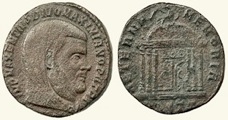
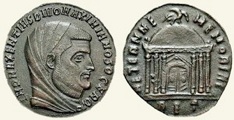
IMP MAXENTIUS, IMP MAXENTIUS,
DIVO MAXIMIANO PATRI/ DIVO MAXIMIANO [GALERIUS] SOCERO/
AETERNAE MEMORIAE AETERNAE MEMORIAE
RIC VI Rome 251 RIC VI Rome 255
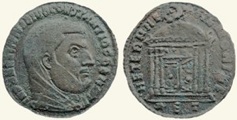
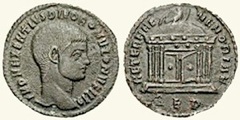
IMP MAXENTIUS, IMP MAXENTIUS,
DIVO CONSTANTIO COGN/ DIVO ROMULO N V FILIO/
AETERNAE MEMORIAE AETERNAE MEMORIAE
RIC VI Rome 252 RIC VI Rome 256
According to Mats Cullhed (referenced below, at p 76), after the death of Galerius in April/ May 311 AD:
“... Maxentius went on to formulate ... his ambitions of supreme power by creating a new dynasty of emperors of Rome ... For the first time since 307/8 AD, he coined for emperors other than himself:
✴but only for deceased rulers [to whom he was related]:
-[the divi Galerius, Maximianus and Constantius, in addition to divus Romulus];
✴completely ignoring:
-[the living Augusti] Constantine, Licinius and Maximinus; and
-[the living but retired] Diocletian ...”
Sabine MacCormack (referenced below, at p 112) described the minting of this series of coins as:
“... the perfect numismatic example ... of how the idea of consecratio could be used as a propaganda weapon, as a claim for legitimacy.”
Like Maxentius’ earlier series of consecration coins for divus Romulus of 309 AD (described in my page on Consecrated Tetrarchs: Mausoleum Coins), all these coins:
✴were produced for each subject at both Rome and Ostia;
✴bore the reverse legend ‘AETERNAE MEMORIAE’ (expressed in the nominative ‘AETERNA MEMORIA’ on the coins from Ostia); and
✴had reverse designs that depicted domed funerary structures (as evidenced by an eagle perched above, to symbolise apotheosis).
However, unlike the funerary structures of the first series for divus Romulus, those of this later series were characterised by a facade of either four or six columns flanking the door.
RIC VI (referenced below) catalogued 24 coins in this series:
✴The great majority (20/24) had obverse legends that alluded to Maxentius’ dynastic link with the deceased (discussed below).
✴The remaining 4/24 obverse legends were:
•DIVO MAXIMIANO SEN AUG - RIC VI: Rome 250 and Ostia 24; and
•DIVO MAXIMIANO IUN AUG - RIC VI Rome, 246 and 253.
I suggest below that Maxentius produced these four ‘SEN/ IUN AUG’ coin types shortly before the 20 coin types of the dynastic series proper.
Consecration Processes in Rome (?)
Mats Cullhed (referenced below, at p 78) pointed out that:
“... consecration, ideally, should take place in Rome, where the Senate would formally recognise the divine status of the [now deceased] emperors. ... As master of Rome, [Maxentius] could stage the creation of the new divi and [thereby] have his [own] right to the throne confirmed”.
The following paragraphs consider the order in which these putative processes took place for the emperors commemorated in Maxentius’ ‘AETERNAE MEMORIAE’ coin series.
Divus Galerius
Carol Sutherland (referenced below) catalogued an odd consecration coin (RIC V1 271) that Maxentius minted for Galerius:
Obverse: DIVO MAXIMIANO AUG: veiled bust of Galerius
Reverse: MEMORIA FELIX: lighted and garlanded altar, flanked by eagles.
The associated note observed that:
“[This] reverse type seems to be anomalous for Rome, and the reverse [of the actual coin examined] has been tooled, though not necessarily so as to altar the mark of another mint [i.e. to make a coin that had been minted elsewhere look like it had been minted at Rome].”
If the coin type was as catalogued, it seems that Maxentius had used a precedent from Constantine’s earlier coins for divus Constantius to commemorate the consecration of Galerius. This implies that he moved quickly after Galerius’ death to consecrate his erstwhile enemy, now his late, lamented father-in-law.
Maximinus and Licinius both also minted for divus Galerius (although Constantine, the third ‘legitimate’ Augustus, did not). However, Maxentius had an important advantage over the Augusti: he could arrange for the formal consecration of Galerius in Rome, complete with the approval of the Senate. It seems to me that this Maxentian coin (if it is correctly catalogued) probably commemorated this putative consecration process shortly after Galerius’ death in April/May 311 AD. In other words, the issue probably pre-dated the second ‘AETERNAE MEMORIAE’ series.
(These coins issued by Maxentius, Maximinus and Licinius are also discussed in the page on Maxentius' Consecration Coins (311 AD)).
Divus Maximanus
Maximian had died in Gaul in 310 AD, either by suicide or execution, following his failed rebellion against Constantine. Once he was safely dead, Maxentius soon found it expedient to ‘forgive and forget’ their past enmity, and to bask in the reflected glory of a deified father. However, he only minted for divus Maximianus within the second ‘AETERNAE MEMORIAE’ series, which suggests that he deferred his father’s formal consecration until after that of Galerius.
I think that this was the point at which Maxentius first issued the Sen/ Iun Aug coins discussed above, and that these coins thus pre-dated the ‘dynastic series proper’. This might well explain the unusual use of the adjectives ‘senior’ (for Maximian) and ‘junior’ (for Galerius) in these coins:
✴In life, Diocletian and Maximian were sometimes referred to as senior Augusti, but generally after their retirement, when the adjective differentiated them from the ‘active’ Augusti (i.e. Galerius and his colleague).
✴However, the adjective ‘junior’ was rarely, if ever, applied to Galerius. (An inscription from Maxentius’ mausoleum complex on Via Appia is another rare example).
Now that both Maximian and Galerius had the same status (dead and deified), they had identical official names (since Galerius had taken Maximian’s name at the time of his accession to the imperial college). Thus, the adjectives ‘senior’ and ‘junior’ were needed to differentiate between them (and was, in any case, helpful in reminding people of the exalted status of Maxentius’ father). The need for the adjectives disappeared in the later coins, when Maximian and Galerius were differentiated by means of their respective relationships to Maxentius (respectively, father and father-in-law).
It seems to me that there are two possible occasions on which these Sen/ Iun Aug coins could have been issued:
✴if the coin RIC VI Rome 271 (above) for divus Galerius is correctly catalogued, then the Divo Maximiano Sen/ Iun Aug coins would probably have been minted to commemorate the subsequent consecration of Maximian; but
✴if RIC VI Rome 271 was not minted by Maxentius in Rome, then the Divo Maximano Sen/ Iun Aug coins would probably have been minted to commemorate their simultaneous consecration.
The act of consecrating Maximian in Rome constituted an assertion that Maxentius’ imperial legitimacy exceeded that of Maximinus:
✴the legends on Maxentius’ coins:
-DIVO MAXIMIANO SEN AUG (to the divine Maximian, senior Augustus) and
-DIVO MAXIMIANO IUN AUG (to the divine Galerius, junior Augustus);
✴‘trumped’ those on Maximinus’ coins (eg. RIC VI Cyzicus 75):
-DIVO MAXIMIANO: MAXIMINVS, AVG FIL (to divus Galerius, from Maximinus, his son).
Maxentius could legitimately point out that his father ‘outranked’ Maximinus’ father by adoption, who was, in any case, his (Maxentius’) father-in-law. Perhaps his action was the result of the same political circumstances that prompted him to cease recognising Maximinus as consul in September 311 AD, a sign that, by then, he had decided that the possibility of his incorporation into the ‘legitimate’ imperial college had all but disappeared. This might well explain why Maxentius waited so long to consecrate his father: he now needed another means of defending his inherent right to rule.
Dynastic Series Proper
The 20 coins of the dynastic series proper (four of which are illustrated above) commemorated:
✴IMP MAXENTIUS DIVO MAXIMIANO PATRI (to the divine Maximian, father of the Emperor Maxentius) - RIC VI: Rome 243, 244 and 251; and Ostia 25 and 26;
✴IMP MAXENTIUS DIVO MAXIMIANO SOCERO (to the divine Galerius, father-in-law of the Emperor Maxentius) - RIC VI: Rome 247, 248, 254 and 255; and Ostia 30 and 31;
✴IMP MAXENTIUS DIVO CONSTANTIO COGN (to the divine Constantius, kinsman of the Emperor Maxentius: cognatus, as here, usually meant blood relative: other coins from Ostia used the more accurate adfinis, meaning relative by marriage) - RIC VI: Rome 245 and 252; and Ostia 27, 28 and 29; and
✴IMP MAXENTIUS DIVO ROMULO N V FILIO (to the divine and most noble Romulus, son of the Emperor Maxentius) - RIC VI: Rome 249 and 256; and Ostia 32 and 33.
On the model, I have proposed so far, these coins would have been issued after Galerius and then Maximian had been consecrated, probably in quick succession, in Rome. Romulus had already been consecrated there some two years earlier. Thus, it remains to consider the case of divus Constantius.
Divus Constantius
Maxentius had first minted for divus Constantius at Ticinum and Aquileia in 307 AD, at the time of his alliance with Constantine. Significantly, at that point, he had not done so at Rome. A similar situation can be identified in relation to Maxentius’ own absence from a slightly earlier series of coins that he had minted at Rome for:
✴Maximian, as IMP C MAXIMIANO P F AVG (RIC VI Rome 161); and
✴Constantine, as Caesar (RIC VI Rome 160).
As RIC noted (at note 2), the absence of Maxentius himself from this earlier issue is remarkable. It suggests (at least to me) that Maxentius was sensitive to the position of the Senate when he minted coins at Rome. Thus:
✴at the time of the issue at Rome for Maximian and Constantine, Maxentius did not mint for himself because he not yet secured Senatorial ratification of his elevation (perhaps by Maximian) to rank of Augustus; and
✴at the time of the slightly later issue for divus Constantius at Ticinum and Aquileia, he did not produce similar coins at Rome because he had not secured Senatorial ratification of Constantine’s unilateral consecration of his father.
If this is correct, then the coins that Maxentius minted at Rome for DIVO CONSTANTIO COGN probably commemorated a recent consecration process for Constantius there. If so, this putative fourth consecration process probably gave rise to the ‘dynastic series proper’.
Reverse Designs
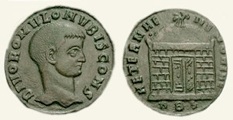
Maxentius for DIVO ROMVLO N V BIS CONS/ AETERNAE MEMORIAE
RIC VI Rome 207 (ca. 309 AD)
The coins of both of Maxentius’ ‘AETERNAE MEMORIA’ series (i.e the series for divus Romulus in 309 AD and that for all four divi in 311 AD) were distinguished not only by this reverse legend but also by their reverse designs, which featured a domed rotunda topped by an eagle. In those of the first series (described in my page on Maxentius' Coins for Divus Romulus (309 AD)), an example of which is illustrated above, the plain facade of the rotunda ( had apparently been constructed using the technique of opus quadratum. I suggest in the page on the earlier coins that this design represented the mausoluem on Via Appia in which Romulus was buried.

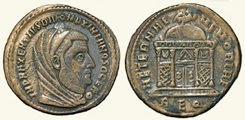
Divo Maximiano, Imperator Maxentius,
patri Maxentius Augustus Divo Maximiano (Galerius) socero
RIC VI Rome 244 RIC VI Rome 248
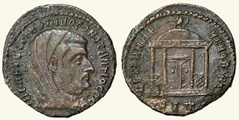
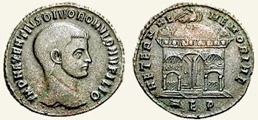
Divo Constantio, Imperator Maxentius,
adfini Maxentius Augustus Divo Romulo filio
RIC VI Rome 245 RIC VI Rome 249
However, the facades of the funerary structures on the 24 coin types in Maxentius’ second series were more elaborate. As noted above, they can be split into two subsets:
✴one in which the reverse depicts a funerary rotunda with a tetrastyle facade (examples of which are illustrated here):
•for divus Maximianus, RIC VI: Rome 243-4;
•for divus Galerius, RIC VI: Rome 246-8;
•for divus Constantius, RIC VI Rome 245; and
•for divus Romulus, RIC VI Rome 249; and
✴one in which the otherwise similar funerary rotunda has a hexastyle facade (examples of which are illustrated at the top of the page):
•for divus Maximianus, RIC VI: Rome 250-1; and Ostia 24-6;
•for divus Galerius, RIC VI: Rome 253-5; and Ostia 30-1;
•for divus Constantius, RIC VI Rome 252; and Ostia 27-9; and
•for divus Romulus, RIC VI Rome 256; and Ostia 32-3.
Scholars have long argued about whether the domed structures on the reverses of the coins of these two series:
✴represented one or more real physical buildings; or
✴simply acted as visual metaphors for:
•dynastic interment (the domed structures themselves); and
•apotheosis (the eagles on the domes).
As discussed below, the variability of the designs has given weight to this second point of view. However, as Thomas Bayet (referenced below) pointed out, resolution of this debate is hugely complicated by the fact that:
✴we cannot be sure that all the variant forms of these designs have been identified and appropriately classified; and
✴the remains of the real physical structures that might have provided the models for them (i.e. Maxentius’ mausoleum on Via Appia and the rotunda on the Via Sacra) are not sufficiently well-preserved to allow us to recreate the original structures as they existed when the coins in question were struck.
Elisha Ann Dumser (referenced below), who analysed the reverse designs from both series as a single set, argued (at p 146) that:
“... it is highly doubtful that such dramatically diverse architectural types could all refer to the same physical building.”
However, she conceded (at p. 144) that:
“Shifts [between the opus quadratum designs of 309 AD] are rather minor and fall within the expected range of variability for architectural types.”
In other words, considered alone, these reverse designs from the first series could have represented a specific physical building. I suggested in my page on Consecrated Tetrarchs: Mausoleum Coins that this was indeed the case, and that the building in question was the mausoleum on the Via Appia in which Romulus had been buried.
Elisha Ann Dumser also conceded (at p 144-5) that:
“The hexastyle types are also quite stable ... Although not as consistent a representation as the opus quadratum types, they exhibit far less diversity than their tetrastyle cousins [discussed below].”
Thus the reverse design in these coins could have represented a single specific structure (or perhaps a small group of similar structures).
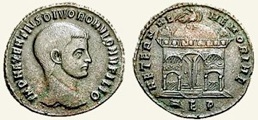

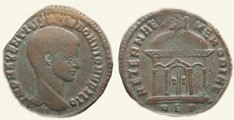
Imperator Maxentius, Divo Romulo filio (RIC VI Rome 249)
Thus, the diversity with which she was concerned was really that of the tetrastyle structure, to which she drew attention at p 147:
“... the remarkable difference among [the tetrastyle coins] indicates that an intention to represent a specific structure was absent.”
This variability is particularly evident among those classified as RIC VI Rome 249 which commemorated divus Romulus (some examples of which are illustrated above). Nevertheless, she conceded (at p 147) that:
“Of the three major reverse types, the tetrastyle [reverses] most closely approach the singular design of the Sacra Via Rotunda Complex”.
She pointed out (at p. 147) that:
“Roman die engravers were capable of producing a consistent and readily recognisable image of a given built monument, when they so desired. In the case of [these] reverse types, reproducing the façade of the rotunda [in a consistent and readily recognisable manner] does not seem to have been their intent.”
Nevertheless, she further conceded (at p. 151) that:
“... it may be possible to suppose cautiously that a die carver, given a general set of instructions, drew inspiration for the details of his image from the [rotunda] on the Sacra Via. In fact, several tetrastyle reverses do mimic, to a degree, the distinct and unusual form of the Rotunda Complex [illustrated below]:
-The four columns [on these reverses] resemble the columnar façades of the two side aisles, and thus the coins could be said to depict the unique, tripartite division of the façade.
-Each issue emphasises the rotunda’s double doors. [In] a traditional rotunda ... the entrance is masked by a columnar façade, [while] the Rotunda Complex breaks from this mould and features a prominent and elaborate central portal. Perhaps it was just this feature that recommended the building as a model, since the symbolic reverse type required a half-open door.
-On some coins, the dome spans only the central portion of the façade: this closely follows the actual appearance of the Rotunda Complex, and is a feature that distinguished it from other domed rotundas of the time.”
In her final (albeit tentative) conclusions (at p. 189), Elisha Ann Dumser seems to have accepted that Maxentius’ die carvers had indeed been inspired (inter alia) by this building:
“Diocletian and Maximian remain viable [as the original founders of the rotunda], although ... the [consecration] coins tip the scales in favour of Maxentius, as it seems most likely that his die engravers would have honoured his recent construction rather than one belonging to his predecessors.”
It seems to me that whether the rotunda on the Via Sacra was physically represented in these coins, or whether it simply inspired them, is actually not a particularly important. What is important is surely that at least the tetrastyle reverses would have been associated with this rotunda in the mind of the beholder.
Sacra Via Rotunda
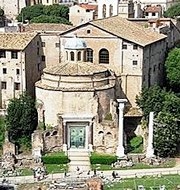
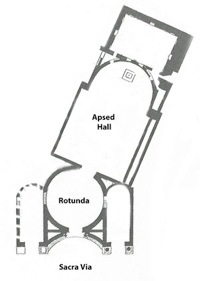
The reluctance of Elisha Ann Dumser (above) to accept that the rotunda complex was physically depicted on these coin reverses was in part due to the inevitable conclusion to which this would lead: that the rotunda complex must have been a cult site devoted to the deified subjects of the obverses of these coins. This hypothesis had, in fact, been put forward by Licia Luschi (referenced below). I have not been able to consult her paper directly, but Thomas Bayet (referenced below, at at p 75) provided a summary:
“... according to Luschi’s analysis, the rotunda should be seen as the ‘Templum gentis Valeriae’, a sanctuary in honour of the gens Valeria, the [alleged] ancestors of Maxentius and the Tetrarchs” (my translation).
However, Elisha Ann Dumser (referenced below, at p. 157) argued that:
“... it cannot be assumed, as has been done so many times in the past, that [this] rotunda complex [functioned as] a religious structure - not when its very design argues so vividly to the contrary.”
She concluded (at p. 168) that:
“Consideration of the entire complex suggests that the rotunda served as a vestibule to the apsidal aula [behind it], which would have housed ceremonial events, such as audiences and tribunals. ... the modest scale of the hall points to use by a high ranking official rather than the Emperor himself. The praefectus urbi [Urban Prefect], as the most powerful magistrate in 4th century Rome, remains a leading candidate.”
Naja Regina Armstrong (referenced below, at p. 244) accepted the archeological evidence for the architectural form of the complex, but she privileged the evidence of the consecration coins:
“Though [the rotunda’s] architecture suggests that [it] served as a 4th century vestibule for the [hall of the] Templum Pacis [behind it], Maxentius’ [consecration] coins raise doubts about the accuracy of this attribution.”
She gave another useful précis of Luschi’s hypothesis (at pp 244-5):
“... Luschi suggests that the rotunda acted as a dynastic temple to the divi of Maxentius’ family [i.e. the gens Valeria]. Prominent since the Republic ... the gens Valeria had gained special privileges, including the licence to bury within the city walls. Maxentius, who used family connections to legitimise his power, may have revived this tradition with a dynastic monument near the site of his ancestor’s historic domus and tomb.”
She thus concluded (at p. 246) that:
“Based on the evidence available, it is likely that the rotunda depicted on Maxentius’ [consecration] coins is equivalent to the [rotunda and its side aisles]. Moreover, the coins’ symbolism suggests that [this edifice] served a commemorative function. Luschi’s hypothesis of a temple to the gens Valeria is the most direct means [by which] Maxentius could have chosen to honour his deceased relatives. ... such a monument accords best with Maxentius’ desire [evidenced by these coins] to tie his rule to [consecrated] members of his gens.”
My Conclusions
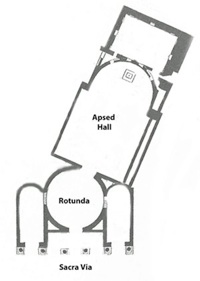
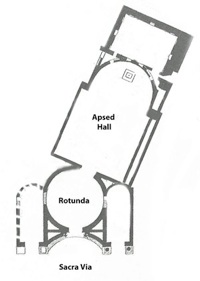
Rotunda Complex
Original flat facade (my suggestion) Final concave facade

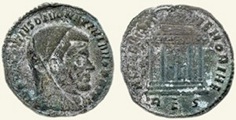
IMP MAXENTIUS, DIVO MAXIMIANO,
DIVO MAXIMIANO PATRI/ PATRI MAXENTIUS AUGUSTUS/
AETERNAE MEMORIAE (hexastyle reverse) AETERNAE MEMORIAE (tetrastyle reverse)
RIC VI Rome 251 RIC VI Rome 244
There is no doubt that Maxentius’ second series of ‘AETERNAE MEMORIAE’ coins was of profound dynastic significance. Thus, it seems to me that their unprecedented reverse designs must have represented a real, dynastic monument. In fact, I think that the hexastyle and tetrastyle reverses represented the rotunda complex on the Sacra Via in its two successive phases of construction (described in my page on Maxentius' Rotunda on the Sacra Via):
✴The 17 hexastyle reverses (which were produced: in Rome (7/18); and in Ostia (10/18);) probably represented the rotunda and its side aisles when the former still had its flat façade. As I have shown in the illustration above, the rotunda itself could well have had (or have been intended to have) two columns in front of it that completed the line of the columns of the side aisles. On this model, the columns on the coin reverses have been displaced sideways in order to reveal the open doors of the rotunda and thus to indicate its funerary significance. The slight variability between these reverse designs could well be accounted for by the fact that the ‘flat façade’ design was never carried through to completion.
✴The 7 tetrastyle reverses (which were all produced in Rome) probably represented the rotunda and its side aisles after the plans were changed to give the former its concave façade. The greater variability among these reverses probably reflects the fact that their dies were carved quite soon after the plans were changed, leaving a great deal to the imagination. Specifically, as Elisha Ann Dumser observed (above), the die carvers were free to draw on this design in order to give the coins an iconography consistent with consecration.
In particular, I think that the apsed hall at the rear of the complex might well have been devoted to the veneration of Maxentius’ consecrated relatives. The contrary view of Elisha Dumser (above), that this space must have had a secular function, was predicated on the assumption that Roman temples never had basilical form. However, the Templum Flaviae Gentis at Hispellum (Spello), which Constantine sanctioned for the worship of his deified predecessors shortly before his own death and deificaton in 337 AD, was in the form of a basilica: and, like the basilica of this Maxentian complex, it was later converted into a church (see my page on Spello: Rescript of Constantine: Templum Flaviae Gentis). I think that the apsed hall of the rotunda complex provided one of the precedents for the later temple at Hispellum.
It is entirely possible that Maxentius initially conceived of the rotunda as a vestibule that cleverly allowed the hall behind it, which had stopped short of the Sacra Via and was oriented at 22° to it, to be harmonised with the new urban environment that he had created along the Sacra Via: after all, the new Maxentian basilica stood immediately to the right of it. However, I think that the plan changed in 311 AD, in order to capitalise on the dynastic opportunities that arose after the death of Galerius (in April/May of that year). It was probably at this point that the apsed space behind the rotunda was called into service for the veneration of the deified members of the gens Valeria.
On this model, it follows that the plan for the façade of the rotunda was changed at some time after the series of consecration processes proposed above, and that the tetrastyle reverses were used only on the later coin types of the second ‘AETERNAE MEMORIAE’ series, all of which were produced in Rome. There is a problem with this:
RIC VI Rome 246, which had a tetrastyle reverse, commemorated Galerius on the obverse as ‘IUN AUG’, which I suggested above should have placed it earlier in the series, before the facade of the rotunda changed.
However, this alone does not completely undermine the hypothesis: this might have been a later coin that employed the earlier obverse legend for a reason that is now unclear.
Read more:
‘RIC’ - see Sutherland (1967) below
E. Dumser, "The Architecture of Maxentius: A Study in Architectural Design and Urban Planning in Early 4th Century Rome" (2005), Dissertation of University of Pennsylvania
N. Armstrong, “Round Temples in Roman Architecture of the Republic through the Late Antique Period”, (2001) Thesis of University of Oxford
M. Cullhed, “Conservator Urbis Suae: Studies in the Politics and Propaganda of the Emperor Maxentius” (1994) Stockholm
T. Bayet, “Architectura Numismatica: Iconographie Monétaire du Temple de Rome, des Mausolées et des Ouvrages Fortifiés au Bas-Empire”, Revue BeIge de Numismatique, 139 (1993) 59-81
L. Luschi, “Iconografia dell' Edificio Romano nella Monetazione Massenziana e il ‘Tempio del Divo Romolo’", Bullettino della Commissione Archeologica Comunale di Roma, 89 (1984) 41-54
S. MacCormack, “Art and Ceremony in Late Antiquity”, (1981) Berkeley
C. H. V. Sutherland, “Roman Imperial Coinage: Volume VI: From Diocletian’s Reform to the Death of Maximinus (294-313 AD)”, (1967, reprinted 1973) London
Maximinus, Augustus Maximus (311-2 AD)
Maxentius in Rome: (311-2 AD) Maxentius' Consecration Coins (311 AD)
Maxentius' Rotunda on the Sacra Via Maxentius and the Gens Valeria
Literary Sources: Diocletian to Constantine (285-337 AD)
Return to the History Index